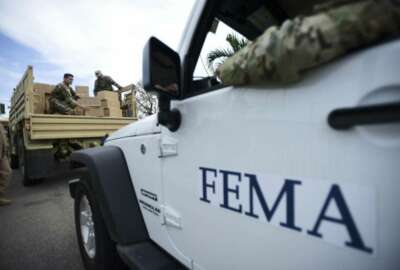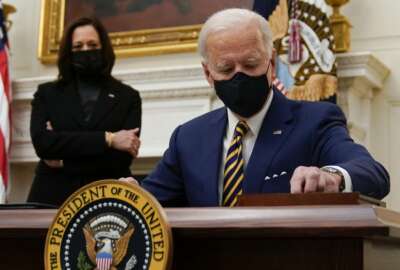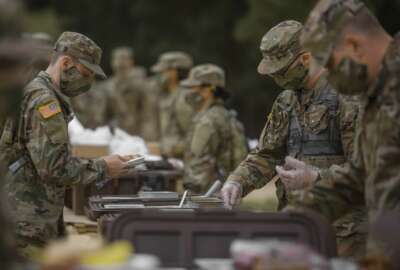
Plans, like for disaster response, are great only if you can carry them out
The federal government has a plan for disaster response but sort of fall short when it comes to execution.
Best listening experience is on Chrome, Firefox or Safari. Subscribe to Federal Drive’s daily audio interviews on Apple Podcasts or PodcastOne.
Winning coaches have a game plan, then work like the devil to make sure players can execute that plan. The federal government has a plan for disaster response but sort of fall short when it comes to execution. That’s the essence of a detailed report heard by a Senate Homeland Security and Governmental Affairs committee. It was created by a group called Business Executives for National Security (BENS). Federal Drive with Tom Temin got more details from President and CEO Ret. Army Gen. Joseph Votel.
Interview transcript:
Tom Temin: Gen. Votel, good to have you back.
Joseph Votel: Hi Tom, great to be with you again.
Tom Temin: And your group has been working on this report, really, since the pandemic. Now we have had a good old fashioned national crisis to deal with, and it’s been a mixed record hasn’t it?
Joseph Votel: Yeah that’s right. Last March, as we watched our nation kind of devolve into the pandemic we were paying very, very close attention to this so we really started focusing on this about a year ago and it remains a very important and relevant topic in our view.
Tom Temin: And so, one of the main recommendations that BENS has made is to include pandemics and other kinds of disasters into the roster of disasters as they’re defined by the Stafford Act. Give us some more detail on that.
Joseph Votel: Yeah so the Stafford Act really is designed to help get resources, money, people, leadership focused on the problem very, very quickly. And it’s largely been focused on natural disasters. And it’s served us pretty well here in the past frankly and we do pretty well in managing those types of events. But what we’ve seen with the pandemic and what we, I think what we can potentially see with greater threats like, for example a cyber strike on the United States – an attack on our infrastructure, our critical energy grid infrastructure – these types of things, these sustained national emergencies really expose vulnerability. So including these types of events into the Stafford Act allows the government to more quickly declare an emergency, get resources going the right direction and importantly, get it into the right lanes so that we can address this.
Tom Temin: And one of your high-up recommendations is prioritizing the exercising and testing of plans. And when it comes to kinetic-types of events like floods and fires hurricanes, we’re pretty good at testing those and there have been live fire and CBRNE [Chemical, Biological, Radiological, Nuclear, and Explosives] type of events that we can get people in motion. Something like a pandemic, there’s little more subtle exercise required. What do you envision happening in a case like that where it’s hard to exercise because you don’t move fire trucks and large numbers of people around in the case of a pandemic?
Joseph Votel: Yeah that’s a great point, Tom. So you know I think you know in this area – this is an area where simulation can help us a lot. And the military does this a lot – they simulate things and it puts people into realistic environments and so this is a way we can simulate the actual activities of a pandemic or some other widespread piece here. The more important part of the exercise is bringing the actual leadership together to have to work through the problems. I think one of the challenges we do have is that when when the pressure is not on, when we’re not faced with an immediate crisis it’s too easy to delegate participation in those types of important preparatory exercises to lower levels. But it’s really important to get the decision makers in it. So well-crafted, focused exercises that make good use of simulation and really drive interaction between different parts of the government and include the decision makers is the most important aspect of this.
Tom Temin: And in what we’ve seen in the past year it seems like the civilian muscle is the one that needs development here because, as a retired [Central Command] commander you must be a little uneasy at the degree to which the military and the national guard was used in some situations for a domestic pandemic.
Joseph Votel: Well, I’m sure that – I mean this is a muscle movement within the military in terms of preparing for things. It’s really part of, I think what the American people expect us to do and it’s part of the culture that we have. And I think the military, at least from my own experience, I mean we’re very happy to support civilian leaders wherever we have here in the United States or overseas – wherever it has to be but I also think we have to be careful about always applying military solutions to these problems. In many cases, even the military with all the resources, people and everything it has doesn’t have everything. And what we learn about an incident like the pandemic is it takes all levels of government and it takes all sectors – public, private and civil – to come together. When you bring them together that’s where the resources are to actually get after the problem.
Tom Temin: We’re speaking with Ret. Army Gen. Joseph Votel, president and CEO of the Business Executives for National Security. And everybody deals with supply chains whether military or civilian, and we really found some flaws in supply chains both at the source of supply and in the ability to get them distributed. And so how can the idea of stockpiling and logistics come into better play in something like a pandemic?
Joseph Votel: Well, I think first and foremost we have to have a serious discussion and make some decisions about the supplies that we need in our National Stockpile. This has to be done, this is part of the exercise program, this is part of the preparatory work to make sure we have a good idea of what it is that we need to have in there. Second of all, we need to make sure that we have a way for the private sector to contribute to that, and to understand where additional supplies may be. So one of the recommendations we make is the establishment of a national disaster app that private sector businesses can opt into that would give them situational awareness, give them the ability to share information and to understand the bigger piece and know where supplies are. The final piece we recommend is the establishment of a surge center within the National Response Coordination Center at FEMA. The idea of surge is getting the right people supplies, equipment to the right place at the right time. And we don’t really have a great mechanism to do that. We don’t have a great common operational picture, to put it in military parlance, as to what’s going on. So the surge center really is designed to perform that function for us.
Tom Temin: Because I think the private sector and supply chain logistics piece of this would really be important because what we’ve found in past stockpiling is that things go bad sitting in a warehouse.
Joseph Votel: Sure.
Tom Temin: And if – even a mass could deteriorate sitting for 10 years or something. And so you need that ability to get fresh in there in large quantities. So that’s –
Joseph Votel: That’s exactly right. And this is why, one of the things that really has to take place is the discussions between the private sector and government partners over the supply, over our stockpile. And being able to rotate things in and out and incentivizing businesses to do that and participate in the program. I think this is really, really, really important. And we have to stop looking at private sector as vendors and we have to look at them as partners in addressing these types of problems.
Tom Temin: And also, having private sector and government allied in the whole information area. We saw this in the latter phases, finally, of the vaccination distribution. My own experience was you go from CDC to your state site. But what really got done was CVS.
Joseph Votel: Right, and the whole communications piece of this, I think, is extraordinarily important in terms of how we do this. And it has to start at the top with the federal government in terms of providing clear information, and really working I think, to get people aligned up and down from state, from federal, all the way down to local level as much as we can. And then across the sectors to make sure people understand what the priorities are, where the needs are, what the approach is, and how we’re communicating to the American public about it. These I think are incredibly important things. And everyone has to be involved, but it has to start at the top.
Tom Temin: Yeah, so looking in summary at your report, there’s a couple things Congress needs to do. But primarily, it is just execution, practice, and tightening on the part of the executive branch, I would say, is how your main findings come down.
Joseph Votel: That’s true. There are a few things that that Congress can do. And there are some policy and organizational things that the administration and the departments can do. But I also, I also want to make sure that we highlight that there – this is a linkage down to the state and local level as well. In general, we talked to a number of state emergency managers, as part of our process and almost to an organization, they were excellent in terms of what they do. And they serve the people, their citizens and their state quite well. But they have challenges as well. They have challenges and technology. They have challenges and communication. We have 50 different systems out here under our kind of our federal approach here. And so we have got to work to link better up – all the way up and down the chain. And that only works when people have the willingness to kind of self synchronize and self align up and down.
Tom Temin: As this report gets out, you have presented it to the subcommittee in the Senate and so on so far. Are you getting nods like, “Yeah, you guys are right on this?”
Joseph Votel: Yeah, we have. We’ve gotten some really great support. Sen. Maggie Hassan who is the chair of the subcommittee that we talked to last week was actually one of our commissioners, as was Sen. Bill Cassidy. And both of them have been extraordinary in this. We’ve had other members of Congress – John Katko from New York, Elissa Slotkin, from [New York] – have been key interlocutors. And we’ve talked to a variety of others as well, who all have interests and they have in some cases, their specific interests for them. But in other interests there, they are more – really focused on this. So yes, we’re getting traction on this. We know it’s a campaign plan, and we know it’s going to take some time.
Tom Temin: What’s next on the plate for BENS now?
Joseph Votel: We’re, like everybody else we’re starting to emerge out of the pandemic here and trying to return to the new normal here: How we bring people back together but do it in a safe manner, but also accommodate people that are going to continue to participate virtually. We’re very keen to make sure that we – I think the area we’re paying a lot of attention right now, Tom, is this idea of competitiveness. You know, the National Security Strategy really focuses in on this. And we’re not going to really advise the department on how to militarily, Department of Defense how to militarily do that. But there is a private sector component to this. And so one of the key things we want to try to do is help understand that and then make the broader private sector understand exactly what is at stake with this competition that we have, particularly with China.
Tom Temin: Ret. Army Gen. Joseph Votel is president and CEO of the Business Executives for National Security. Thanks so much for joining me.
Joseph Votel: Tom, great to be with you. Thanks.
Tom Temin: Find this interview and a link to the latest findings at FederalNewsNetwork.com/FederalDrive. Hear the Federal Drive on demand. Subscribe at Apple Podcasts or wherever you get your shows.
Copyright © 2025 Federal News Network. All rights reserved. This website is not intended for users located within the European Economic Area.
Tom Temin is host of the Federal Drive and has been providing insight on federal technology and management issues for more than 30 years.
Follow @tteminWFED
Related Stories






